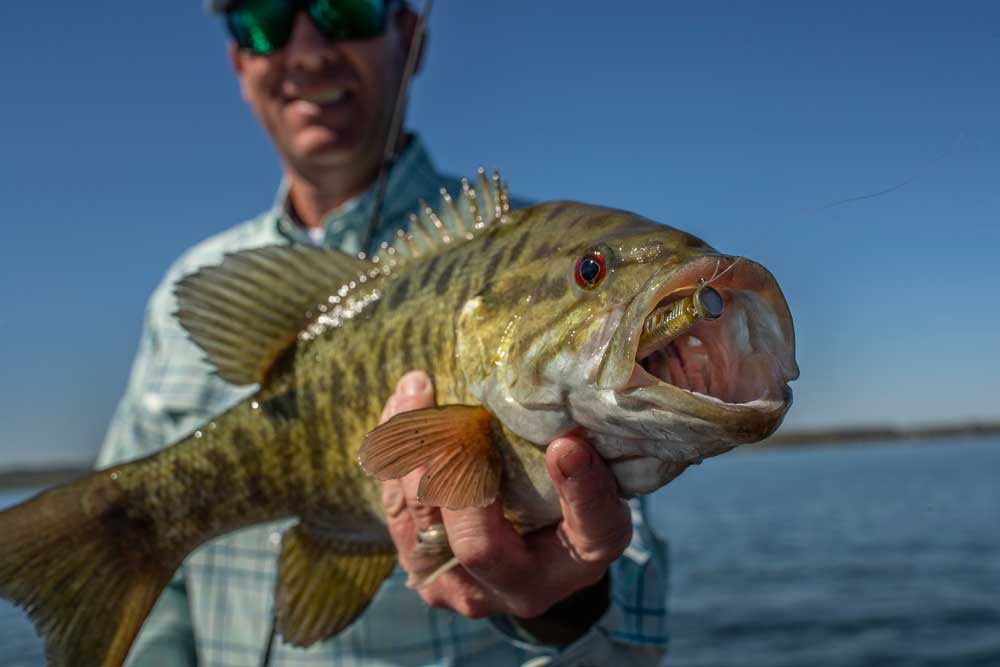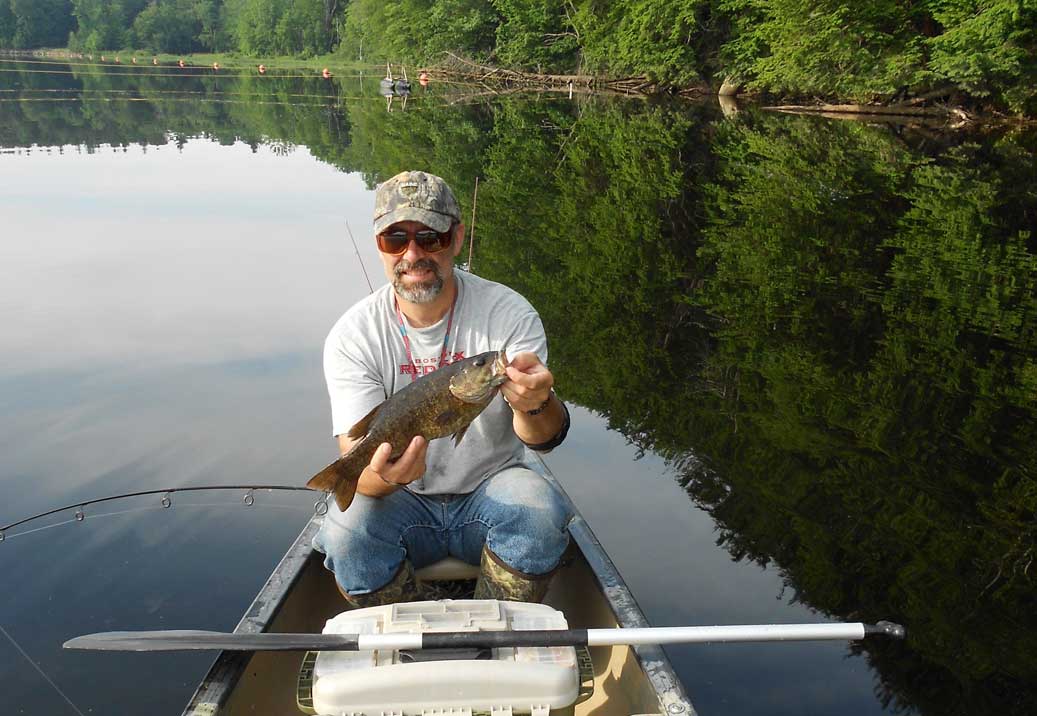Bob Humphrey

The smallmouth bass, smallie or bronzeback (Micropterus dolomieu) is a member of the Centrarchidae or sunfish family, which also includes its larger cousin the largemouth bass, the rock bass, numerous species collectively called sunfish or bream and crappie. There are two recognized subspecies, the nominate and more widespread northern (M. d. dolomieu) and the Neosho (M.d. velox).
Like other members of the black bass group, smallmouth bass have a slender fusiform body, unlike the taller, flatter bodies of sunfish. They generally have olive to dark brown coloration that fades to yellowish white ventrally, with dark brown vertical bars or blotches on the body and dark brown, horizontal lines on the head.
The Differences Between Largemouth and Smallmouth Bass
They are best distinguished from their larger cousins by three features. In largemouth, the upper jaw extends rearward past the eye while it stops roughly at the eye in smallmouth. Largemouths have a deep notch separating the dorsal fins while the smallmouth has no such break. Largemouths also lack vertical lines on the body, though they’re sometimes obscure on smallmouths. They can grow up to 30 inches and weigh 10 pounds but specimens over four to five pounds are uncommon in the South and rare in more northern areas with shorter growing seasons.
It is important to know how to identify a smallmouth from other varieties of bass, as many states have a different limit on them than other bass species. Make sure you check the regulations on any body of water you fish, as the legal limit of smallmouth can vary from lake to lake.
Range and Distribution
Smallmouth bass are native to eastern North America from Manitoba and Quebec down to the Tennessee River system and west to Oklahoma, including the upper and middle basins of the Mississippi River, the St. Lawrence River, the Great Lakes system and the Hudson Bay basin.
The Neosho race is native to the central interior highlands of southwestern Missouri, northern Arkansas and northeastern Oklahoma. However, smallmouth bass have been introduced well outside their native range and now occur throughout much of the United States.
Unlike largemouth bass, which generally prefer warm shallows with dense aquatic vegetation, smallmouths prefer the cooler water of deeper ponds, lakes and rivers, particularly in areas with rock, gravel or cobble substrate and moving water. They also prefer clear water with a constant current.
Diet
Smallmouth bass have a diverse diet that includes other fish, aquatic insects and invertebrates and crustaceans like crawfish. These things become abundant throughout the year in most bodies of water and smallmouth are soon to follow.

Looking for fishing gear? Beat back the heat with new Mossy Oak Fishing apparel. Our new fishing shirts are built for superior sun protection, limitless movement and quick dry fabric so you can focus on what matters most.
Reproduction
As waters warm in the spring, males move into the shallows where they clear a bed or redd — a shallow depression in the substrate — which they will defend and try to attract a mate. Over the spawning period, he may lead several females to the redd where they’ll lay eggs to be fertilized by the male, who remains to guard the nest for up to 10 days, depending on water temperature. Once the fry hatch, males rest and recover for a week or so and then move off to deeper waters leaving the young to fend for themselves.
Conservation and Fishing
Smallmouth bass are intolerant of pollution and therefore a good indicator of a healthy environment. Populations are generally healthy and strong and the biggest issue from a conservation standpoint is translocation. While they’re a popular gamefish, introducing smallmouths to new lake or river systems can have significant negative impacts on native fish populations.
Anglers fish for smallmouth bass in a variety of ways including trolling, drifting, casting and jigging. They also use a diverse array of terminal tackle including diving plugs, spoons and lures, bucktail jigs and soft baits rigged in a variety of ways and live bait like minnows and crawfish. Smallmouth are often targeted by anglers because of their reputation of putting up a good fight.
All About the Smallmouth
The above is everything you need to know about the smallmouth bass. When you understand how to identify a smallmouth, know where it likes to live, know what it eats and its reproductive habits, you will catch more smallmouth. There are clear differences between the smallmouth and largemouth bass. Once you fight one to the boat, it might become your favorite species of bass to fish for.































